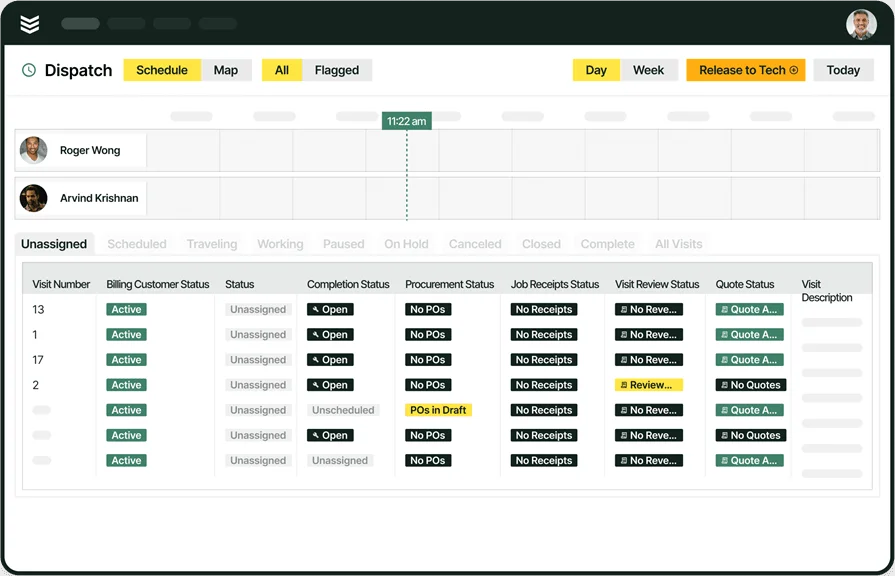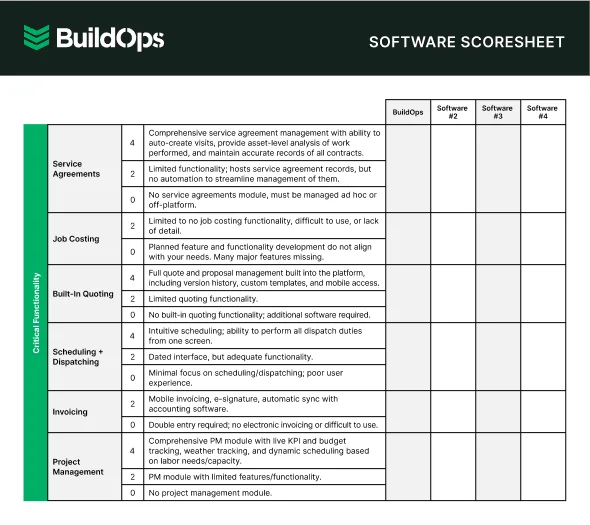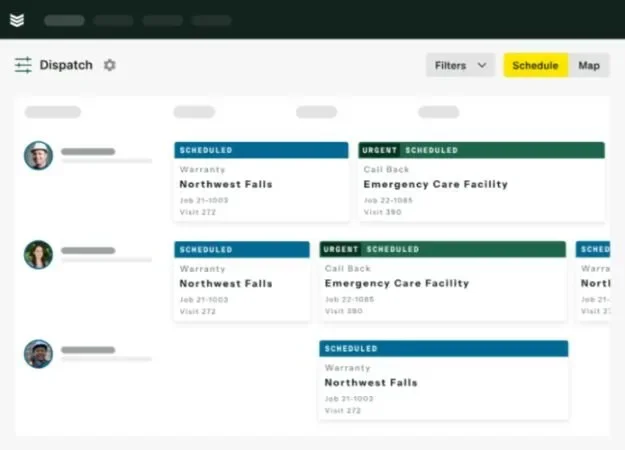Managing crews in commercial contracting goes beyond just showing up on time. It’s about using every hour wisely. With rising costs, tighter timelines, and more pressure on performance, manpower software plays a critical role in keeping projects on track and crews productive.
Whether you’re coordinating field techs, balancing union shifts, or scaling teams across multiple job sites, the right manpower software gives you control. It helps manage availability, assign the right people to the right tasks, and track hours with precision. These tools help eliminate confusion, reduce delays, and give project managers a clearer view of what’s happening in the field.
In this guide, we’ll break down what to look for in manpower software, which features matter most, and how manpower software solutions tie into broader field service management strategies in commercial construction. Here’s what we’ll cover:
- How to choose manpower software that actually fits your crew
- 10 key features to look for in manpower scheduling software
- 8 best manpower software & solutions for your business
- 7 key benefits of software for manpower planning
- 4 important manpower software FAQs answered
First, let’s talk about what factors matter when choosing manpower software for your team.
How to choose manpower software that actually fits your crew
Picking manpower software starts with understanding how your team operates day to day. Whether you're managing rotating shifts, balancing crew availability across job sites, or working under union rules, the software needs to match your workflow—not force you into someone else’s system.
Ask the questions that dig into how your crews move, how they’re managed, and what kind of visibility you need across projects. That’s how you find a solution that works under real jobsite pressure.
- Team type – Are your crews full-time, part-time, or subcontracted? Do they rotate between field work and shop work? Does your workflow change by trade?
- Workload setup – Do you run steady shifts or manage fluctuating schedules? How often do jobs get reassigned? Can the software support short-notice changes or multi-location deployments?
- Compliance & union rules – Do you need to track limits on hours or enforce break times? Can the system flag rule violations before they happen? Does it support job codes or classifications tied to labor agreements?
- Cost & contract terms – Is pricing flexible based on how many people use it? Can you start small and scale later? Are there setup costs, hidden fees, or required long-term contracts?
- Features – Can it handle job assignments by skill, location, or availability? Does it have mobile access for field crews? Can you see real-time updates, labor usage, and job progress without chasing down reports?
Once you’ve nailed down these answers, the path becomes clearer. You’ll know what manpower software solutions can actually support your crew—and which ones will slow you down.
10 key features to look for in manpower scheduling software
When your crew is spread across multiple job sites, juggling schedules, hours, and last-minute requests, manpower software needs to do more than just organize names on a calendar. It has to keep pace with the real-world pressure of commercial service work—because missed hours, scheduling slip-ups, or dispatch confusion hit your bottom line fast. Here are six key features that matter most:
1. Accurate time tracking
Time is money—literally. Manpower management software must have a strong time tracking system that logs hours down to the minute, with job-level breakdowns. For example, when a plumbing contractor has three techs on three different service calls, and one runs over by two hours, tracking that accurately—without back-and-forth texts or paper timecards—keeps payroll clean and billing accurate. Your team should be able to clock in and out from the field, with time synced to the job and task.
2. Real-time scheduling
You can’t afford dead time in the field. Manpower scheduling features need to go beyond drag-and-drop. They should help you see crew availability, job conflicts, and overlapping shifts at a glance. Consider a service company handling HVAC jobs across a metro area. When one tech calls out, you’ve got a five-minute window to reassign someone else before the customer gets frustrated. With manpower scheduling software that updates schedules in real-time, dispatchers can reassign work on the fly—and keep the job on track.
3. Mobile crew access
Crews shouldn’t have to guess where they’re going next. With a connected technician mobile app, every field tech gets real-time job details, clock-in capability, and task notes—all from their phone. Picture a field electrician finishing up a job earlier than expected. Instead of calling dispatch, he checks the app and sees the next assigned task, location, and required parts. No delay, no wasted time. That’s what manpower tracking software solutions should deliver—clarity in the field.
4. Smart dispatch tools
Dispatch is where things break down—or where they can run the smoothest if you get it right. The dispatching features in manpower tracking software should help assign the right person to the right task, using filters like skills, certifications, and location. Say your commercial fire safety crew has a tight job downtown with required permits and equipment. You can’t just send anyone. A smart dispatch board highlights which techs are certified, who’s available nearby, and which vehicle has the needed gear. It saves the dispatcher time—and avoids sending the wrong person.
5. Labor reporting
Data only matters if it’s useful. Reporting & analytics tools should show actual labor costs per job, hours logged per technician, and trends over time—helping you staff smarter and quote tighter. Let’s say your team is bidding maintenance contracts. You pull reports from your manpower tracking software showing that two-person teams finish these jobs 20% faster. Now you can quote with confidence, reduce excess labor, and back it all up with data.
6. Service-to-pay workflow
From work completed to cash collected, manpower software needs to help you close the loop. With invoicing and payments features that integrate with time and job data, your team stops chasing paper. Think about a technician finishing a water heater install at 4 p.m. She closes the job in-app, and within minutes the office sends out an invoice—based on the actual time and materials. The customer gets it on the spot and pays before your tech even leaves the driveway.
7. Smart quoting integration
Your manpower planning doesn’t start when the job begins—it starts when the quote is built. With quoting tools that factor in crew hours, labor types, and availability, manpower tracking software helps you build quotes that are realistic and labor-aware. Let’s say you're putting together a proposal for a multi-day retrofit project. The estimator uses historical data on crew size, labor hours, and task durations. Instead of guessing, the quote includes accurate labor costs and timelines. That means you’re not overpromising or underpricing—and your manpower plan is dialed in before the job even starts.
8. CRM with crew insights
Manpower software should connect customer details with past labor history, and CRM tools that track previous jobs, tech assignments, and service preferences help make that possible. Suppose a customer calls asking for the same crew that installed their last system. With the right CRM, you can instantly pull up which technicians were on the job, what work they did, and how long it took. That helps dispatch assign the same team—or flag any changes that might affect the workflow.
9. Agreement-driven scheduling
Service contracts are only profitable when labor is used wisely. Service agreement tools in manpower software help automate recurring job assignments based on contract terms and available labor. Say your team manages 50+ quarterly inspections across different buildings. With agreement-based scheduling, each visit is automatically slotted into your calendar based on tech availability, location, and workload. You stay ahead of due dates and avoid scrambling last minute.
10. Fleet-to-crew coordination
Vehicles are part of your labor strategy. Fleet management features in manpower software let you match trucks and tools with the right teams—so no one shows up under-equipped. Take a job that needs a specific lift or larger tool inventory. The system shows which crew has the truck with the right setup, who’s assigned to that vehicle, and how far they are from the next job. Instead of splitting crews or doubling up trucks, you assign efficiently and move faster.
8 best manpower software & solutions for your business
There’s no shortage of manpower tracking software out there—but only a few tools are actually built to handle the complexity of field service work. Whether you’re managing commercial technicians, rotating shifts, or multi-site jobs, the right solution should help you assign crews faster, track hours with accuracy, and keep jobs moving without the back-and-forth.
Below, we’ve listed eight manpower software solutions that stand out for their capabilities in labor coordination, scheduling, and reporting. Each one brings something useful to the table—but not all are created equal for field service contractors. Let’s break down where they shine—and where they may fall short.
1. Best for commercial contractors: BuildOps
BuildOps is a manpower software solution purpose-built for commercial contractors. It combines field scheduling, dispatch, time tracking, and reporting into a single platform that simplifies how you assign, monitor, and support crews. You can view assets across properties, schedule based on availability or certification, and use AI-assisted note-taking to cut down on paperwork. Plus, the mobile app gives your technicians access to job details, checklists, and time logs from anywhere—keeping everyone in sync without the back-and-forth.
Industry Specialization: Commercial
How Pricing Works: BuildOps uses a custom pricing model based on company size, number of users, and feature packages.
What Sets It Apart: Built-in customer hierarchies that organize and display assets across multiple properties under one client—know what needs attention, where, and who’s responsible.
Key Features:
- Advanced non-exact search to prevent duplicate client or property files
- Real-time dispatch board with skill and availability filters
- Mobile access so techs can receive jobs and submit reports instantly

Explore our FSM suite
We help contractors manage crews, improve workflows, and complete jobs faster.
2. Best for residential contractors: Saviom
Saviom’s workforce planning software supports scheduling and labor forecasting across different types of workers, including part-time, full-time, and contract crews. It’s designed to help residential contractors match staff to jobs based on role, skill, and availability while avoiding overbooking or idle hours. Real-time dashboards and drag-and-drop tools offer visibility over daily assignments and long-term forecasts. It’s packed with features but may feel overly corporate for smaller field service teams who want fast, field-ready tools.
Industry Specialization: Residential contractors and staffing
How Pricing Works: Based on custom enterprise quote
What Sets It Apart: Advanced forecasting features for long-term labor planning and capacity mapping
Key Features:
- Visual scheduling board with drag-and-drop crew assignments
- Resource utilization tracking for balancing workload
- Role-based filters for matching techs to appropriate tasks
3. Best for general contractors: Procore
Procore helps general contractors manage labor assignments across long-term projects. Built to integrate with broader construction workflows, it centralizes workforce planning, certifications, and job site requests into one tool. GCs can submit labor requests, assign teams to phases of work, and oversee site access—all while monitoring manpower needs over the life of a project. Its strength in large project oversight might make it excessive for service-based contractors who work on shorter, high-volume jobs.
Industry Specialization: General contractors and large construction firms
How Pricing Works: Custom quote based on seats and project size
What Sets It Apart: Ties manpower planning directly to project phases and site logistics
Key Features:
- Role- and certification-based crew assignments
- Field request tracking tied to job phases
- Integration with wider project management suite
4. Best for enterprise workforce planning: WorkForce Software
WorkForce Suite is built for large, multi-location teams that need to balance compliance, scheduling, and timekeeping in one system. It’s strong on labor law adherence, letting admins build rules around rest periods, max shift lengths, and union agreements. Dashboards give insight into leave requests, overtime, and site-level coverage for companies operating across multiple job types and schedules. However, its enterprise-grade setup and heavy configuration needs may slow down smaller teams that want something easier to deploy.
Industry Specialization: Large organizations with union and compliance needs
How Pricing Works: Tiered licensing based on company size
What Sets It Apart: Automated rule engines that flag violations in real-time scheduling
Key Features:
- Compliance-based scheduling with union labor logic
- Time-off and shift swap management
- Labor cost forecasting across departments or job sites
5. Best for mobile operations teams: Connecteam
Connecteam’s operations suite helps field service teams coordinate daily tasks, track time, and stay connected through a mobile-first interface. It’s especially useful for mobile crews that don’t return to a central office, giving them access to schedules, forms, and updates on their phone. Managers can track attendance, assign jobs, and send shift-specific instructions, all within one app. However, while it excels in mobile usability, it lacks the depth needed for more complex labor forecasting or large-scale manpower planning.
Industry Specialization: Mobile field teams and small-to-mid service companies
How Pricing Works: Tiered plans based on number of users and feature sets
What Sets It Apart: Intuitive mobile tools for tracking time, tasks, and communications
Key Features:
- Drag-and-drop scheduling with shift instructions
- Built-in chat and task confirmation from field
- Time tracking and automated timesheet approval
6. Best for time & productivity tracking: Clockify
Clockify helps field service businesses get visibility into how crew hours are spent. It’s great for contractors who want clean logs of when workers clock in, how long they spend on-site, and where labor time is going across different jobs. Teams can use it via desktop or mobile to start timers or log hours manually, and project managers can export reports to spot patterns and compare labor estimates to actuals. It’s lightweight and easy to adopt—but doesn’t offer advanced dispatching or crew assignment features that full manpower management software usually includes.
Industry Specialization: Freelancers, contractors, and small teams
How Pricing Works: Free tier with paid upgrades for features like approvals and forecasting
What Sets It Apart: Extremely simple, fast adoption for clean labor tracking
Key Features:
- One-click time tracking across projects or clients
- Detailed reports for labor cost analysis
- Offline mode for logging hours without signal
7. Best for equipment-heavy crews: Rentman
Rentman is a workforce management platform built for companies coordinating people and equipment. Originally made for AV and event industries, it’s now used by field teams that depend on tightly scheduled labor and gear. It lets you assign both staff and resources to jobs, helping avoid conflicts and make sure each crew has the tools they need. Because it was built with a different industry in mind, some field service companies may find it lacking deeper job costing or time tracking integrations.
Industry Specialization: AV, event crews, and equipment-heavy field service
How Pricing Works: Subscription model based on team size and features
What Sets It Apart: Dual scheduling of people and assets from one board
Key Features:
- Calendar view of team and equipment use
- Crew availability tracking by location and skill
- Equipment check-in/check-out with staff tagging
8. Best for large hybrid teams: Microsoft Teams WFM
Microsoft Teams’ workforce management tools help larger organizations manage shift scheduling, task coordination, and communication from one platform. Its integration with Microsoft 365 makes it ideal for hybrid teams who split time between office and field. Managers can create recurring shifts, approve time off, and post updates directly into shared team channels. While powerful in structure, it may be too enterprise-focused for contractors needing job-specific labor views or in-depth field scheduling.
Industry Specialization: Large hybrid and enterprise organizations
How Pricing Works: Included with Microsoft 365 plans or licensed as add-on
What Sets It Apart: Deep integration with existing Microsoft tools and workflows
Key Features:
- Shared shift calendars with time-off approvals
- Group chats and announcements by job role
- Integration with Excel for timesheets and labor analysis

Compare crew management tools
Decide on the optimal tool for you with our easy to use software scoresheet.
7 key benefits of software for manpower planning
Manpower software helps contractors stay in control when things on-site shift fast. Whether you're juggling crews across jobs or adjusting to last-minute changes, the right system keeps your team focused and your schedule intact. These benefits show how manpower scheduling software solutions help field service businesses use labor efficiently, cut down on delays, and stay sharp in the middle of the workday chaos.
1. Smarter crew scheduling reduces downtime
When you’re managing rotating shifts and multiple job sites, even small scheduling gaps can add up to hours lost. Manpower scheduling software helps reduce that waste by automatically surfacing availability, location proximity, and certifications in real time. Systems that build on field service scheduling processes give dispatchers a clearer picture of where to slot crews next—keeping more boots on the ground and fewer on standby.
2. Greater workforce visibility across teams and jobs
You can’t fix what you can’t see. With manpower tracking software solutions that centralize field data, supervisors can track which crews are assigned where, how long tasks are taking, and what work is still pending. Many of today’s field workforce management systems are designed to give you live insights into both job progress and crew activity across sites, helping you act faster when things veer off track.
3. More accurate labor forecasting
Getting future jobs staffed correctly starts with knowing how your teams performed in the past. By using time logs, task durations, and productivity benchmarks from manpower software, you can project labor needs for upcoming work with greater accuracy. This kind of foresight, often built into field service planning tools, helps contractors avoid overcommitting or running shorthanded during critical phases of a project.
4. Faster reaction to last-minute changes
Job changes don’t wait for a clean calendar. Whether it’s a no-show, a new job request, or a delay on-site, manpower scheduling software helps field managers adapt without scrambling. Platforms that support dynamic field service operations allow real-time reassignments and shift updates—so work keeps moving without delay or confusion.
5. Better labor cost control
Small inefficiencies—like long idle times or untracked overtime—can quietly drain margins over time. Manpower software surfaces these issues early by tying time tracking directly to jobs and reporting actual hours worked vs. planned. With systems tied into field service dashboards, leadership can quickly pinpoint trends, investigate outliers, and adjust staffing models based on actual field data.
6. Streamlined crew communication
Too often, crews are in the dark about schedule changes, job notes, or client instructions. Manpower platforms that connect the office and field reduce that gap, giving techs mobile access to everything from site info to task checklists. These tools are especially effective when layered into broader field workforce management software that syncs updates instantly and logs all crew interactions for accountability.
7. Less admin, more field time
Manually building timesheets, tracking shifts, and entering updates eats away at time that could be spent on actual work. The best manpower tracking software solutions simplify these tasks—automating clock-ins, syncing schedules, and integrating with payroll or reporting systems. The result? Admin teams do less chasing, field crews do less waiting, and everyone spends more time focused on jobs, not paperwork.
4 important manpower software FAQs answered
There’s no shortage of questions when it comes to choosing manpower software for your field service operation. Whether you're considering your first platform or re-evaluating what you use today, these answers give you clarity on what to expect, who it’s for, and how to get the most from it.
1. What is manpower software?
Manpower software is a tool used by contractors to manage crews, assign jobs, and track labor across job sites. It gives you visibility over who’s working where, when they’re available, and what jobs they’ve completed. For contractors, the software is crucial for optimizing team utilization.
You might also hear it called workforce management software, especially in larger companies. Both terms refer to systems that organize schedules, labor hours, and personnel across field operations.
2. How much does manpower software cost?
Pricing for manpower tracking software depends on how many people use it, which features are included, and how your business is structured. Here’s a breakdown of common pricing models:
- Per-user monthly fee (entry-level): Usually $15 to $35 per user per month, this covers basic time tracking, shift management, and crew calendars—ideal for small service teams or startups with predictable workloads.
- Feature-based tier (mid-range): Typically $150 to $400 monthly for a base package that includes scheduling, dispatching, mobile access, and some reporting—best for growing contractors balancing multiple jobs and crew types.
- Enterprise package (advanced): Starts around $500+ per month, often with custom pricing. These plans add custom workflows, integrations, forecasting, and compliance tracking for larger operations with dozens of techs or union labor rules.
3. Who needs to use manpower software?
Manpower software is essential for any contractor managing labor across active job sites. If you rely on people to deliver services, meet timelines, or juggle multiple jobs a day, this tool makes the process tighter and clearer.
- Field service companies dispatching technicians to different locations
- Project managers coordinating rotating crews and multiple timelines
- Businesses handling seasonal labor and fluctuating job volume
- Contractors working under union agreements or strict labor rules
- Admin and back-office teams responsible for payroll, scheduling, or reporting
4. What are best practices for using manpower software?
Getting value from manpower software isn’t just about turning it on. How you use it—and how your team adopts it—makes all the difference. These best practices help make sure your software becomes part of the job, not just another system.
- Build out real shift templates and job roles to speed up scheduling
- Use mobile access to keep field techs connected and updated in real time
- Sync time tracking with payroll or accounting to reduce manual data entry
- Assign work based on skills and certifications to avoid delays on-site
- Integrate job notes and photos so reporting is clean and organized
- Track actual vs. estimated labor hours to fine-tune your planning
- Set permissions by role to keep data clean and avoid confusion
- Review dashboards weekly to catch bottlenecks before they snowball
Managing labor in the field has never been simple. Between shifting schedules, multi-site jobs, compliance demands, and tight deadlines, manpower isn’t just a resource—it’s the core of your business. The right manpower software helps you manage that resource with precision. It lets you assign tasks based on skill, react to surprises in real time, and keep every hour accounted for without drowning in manual updates.
Whether you’re dispatching five techs or fifty, software that brings together scheduling, mobile access, time tracking, and labor reporting gives your operation a serious edge. Platforms like BuildOps combine all of these in one place—purpose-built for commercial field service contractors who don’t have time for scattered tools or guesswork.

See BuildOps in action
Check out the platform in action, ask questions, and model workflows.







